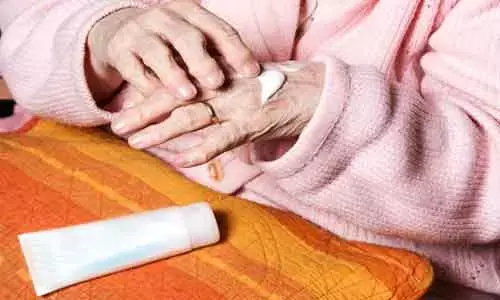- Home
- Medical news & Guidelines
- Anesthesiology
- Cardiology and CTVS
- Critical Care
- Dentistry
- Dermatology
- Diabetes and Endocrinology
- ENT
- Gastroenterology
- Medicine
- Nephrology
- Neurology
- Obstretics-Gynaecology
- Oncology
- Ophthalmology
- Orthopaedics
- Pediatrics-Neonatology
- Psychiatry
- Pulmonology
- Radiology
- Surgery
- Urology
- Laboratory Medicine
- Diet
- Nursing
- Paramedical
- Physiotherapy
- Health news
- Fact Check
- Bone Health Fact Check
- Brain Health Fact Check
- Cancer Related Fact Check
- Child Care Fact Check
- Dental and oral health fact check
- Diabetes and metabolic health fact check
- Diet and Nutrition Fact Check
- Eye and ENT Care Fact Check
- Fitness fact check
- Gut health fact check
- Heart health fact check
- Kidney health fact check
- Medical education fact check
- Men's health fact check
- Respiratory fact check
- Skin and hair care fact check
- Vaccine and Immunization fact check
- Women's health fact check
- AYUSH
- State News
- Andaman and Nicobar Islands
- Andhra Pradesh
- Arunachal Pradesh
- Assam
- Bihar
- Chandigarh
- Chattisgarh
- Dadra and Nagar Haveli
- Daman and Diu
- Delhi
- Goa
- Gujarat
- Haryana
- Himachal Pradesh
- Jammu & Kashmir
- Jharkhand
- Karnataka
- Kerala
- Ladakh
- Lakshadweep
- Madhya Pradesh
- Maharashtra
- Manipur
- Meghalaya
- Mizoram
- Nagaland
- Odisha
- Puducherry
- Punjab
- Rajasthan
- Sikkim
- Tamil Nadu
- Telangana
- Tripura
- Uttar Pradesh
- Uttrakhand
- West Bengal
- Medical Education
- Industry
Sports with bat or racket not tied to thumb-base osteoarthritis

Repetitive joint use is a risk factor for osteoarthritis, which is a leading cause of disability. Sports requiring a bat or racket to perform repetitive high-velocity impacts may increase the risk of thumb-base osteoarthritis. However, this hypothesis remains untested.
Within a community-based cohort, a self-reported history of participation in racket or bat sports was not associated with an increased odds of having radiographic or symptomatic thumb-base osteoarthritis in the dominant hand, reported a recent study published in the Journal of Athletic Training.
Researchers from the Division of Rheumatology, Allergy, & Immunology, Tufts Medical Center, Boston, MA, USA aimed to determine if a history of participation in racket or bat sports is associated with the prevalence of thumb-base osteoarthritis.
A descriptive epidemiological study was conducted at four clinical sites which included men and women from the community. Eligible participants had dominant hand radiographic readings, hand symptom assessments, and historical physical activity survey data.
A history of exposure to racket or bat sports (baseball/softball, racquetball/squash, badminton, table tennis, tennis [doubles/singles]) was based on self-reported recall data covering 3 age ranges (12–18 years, 19–34 years, 35–49 years).
Prevalent radiographic thumb-base osteoarthritis was defined as someone with Kellgren-Lawrence grade≥2 in the first carpometacarpal joint or scaphotrapezoidal joint at the OAI baseline visit. Symptomatic thumb-base osteoarthritis was defined as the presence of radiographic osteoarthritis and hand/finger symptoms.
The authors included a total of 2309 participants. The results showed that among 1049 men, 355 (34%) and 56 (5%) had radiographic or symptomatic thumb-base osteoarthritis, respectively; and among 1260 women, 535 (42%) and 170 (13%), respectively.
After adjusting for age, race, and education level, we found no statistically significant associations between a history of any racket or bat sport participation and thumb-base osteoarthritis.
Hence, the authors concluded that "within a community-based cohort, a self-reported history of participation in racket or bat sports was not associated with an increased odds of having radiographic or symptomatic thumb-base osteoarthritis in the dominant hand."
https://doi.org/10.4085/1062-6050-0208.21
Dr. Nandita Mohan is a practicing pediatric dentist with more than 5 years of clinical work experience. Along with this, she is equally interested in keeping herself up to date about the latest developments in the field of medicine and dentistry which is the driving force for her to be in association with Medical Dialogues. She also has her name attached with many publications; both national and international. She has pursued her BDS from Rajiv Gandhi University of Health Sciences, Bangalore and later went to enter her dream specialty (MDS) in the Department of Pedodontics and Preventive Dentistry from Pt. B.D. Sharma University of Health Sciences. Through all the years of experience, her core interest in learning something new has never stopped. She can be contacted at editorial@medicaldialogues.in. Contact no. 011-43720751
Dr Kamal Kant Kohli-MBBS, DTCD- a chest specialist with more than 30 years of practice and a flair for writing clinical articles, Dr Kamal Kant Kohli joined Medical Dialogues as a Chief Editor of Medical News. Besides writing articles, as an editor, he proofreads and verifies all the medical content published on Medical Dialogues including those coming from journals, studies,medical conferences,guidelines etc. Email: drkohli@medicaldialogues.in. Contact no. 011-43720751


